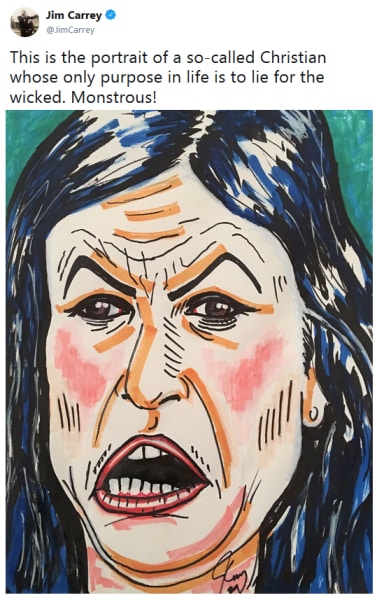Actor Jim Carrey has been pouring his heart and soul into paintings and sharing them on social media.
Those paintings — like his unflattering portrait of Sarah Huckabee Sanders — have sometimes proven to be controversial.
He did a portrait of the late, great Aretha Franklin, but it is not going over well. Did he paint her as a white woman?
The legendary Aretha Franklin passed away at 76 years of age after a battle with pancreatic cancer.
Jim Carrey, known for posting his paintings on Twitter as a form of commentary on current events, shared a portrait of her.
“Look how beautiful a life can be,’ Carrey wrote as he shared the image.
Carrey continued: “Thank you, Aretha!”
The painting that he included of the Queen of Soul, however, caused quite a stir.

Do you see what was controversial about this painting?
In life, Aretha Franklin was a dark-skinned black woman. She is one of the most famous black women on the planet.
In Carrey’s painting, Aretha’s skin looks very, very white in tone.
So much so that, without context, some would never have recognized the subject of his work.
And folks on Twitter took to the replies to notice.

This is not a unique phenomenon, unfortunately.
Whitewashing is found in fanart from all sorts of fandoms. People have drawn famous black women, from real ones like Beyonce to fictional ones like Storm or Tiana, with skin so fair that they don’t even look like tan white people.
Sometimes, there is a genuine prejudice behind it. Racism is real, and sometimes that malice makes its way into art.
In other cases, however, it comes from a lack of familiarity with how to draw or paint someone with dark brown skin.
Some art classes simply don’t train people in it. And because so many white faces dominate pop culture, a lot of white artists do not get much practice.

(As you can see, one person even tweaked the image to pay more accurate tribute to Aretha’s skin tone)
We do not think that Jim Carrey was in any way malicious or racist in his intentions.
Rather, his very light painting was the result of white supremacy’s impact on our culture and the arts as a whole.
This can be a useful learning experience for Carrey and for aspiring artists.
And if you’re ever unsure of how you’re portraying someone, you can always look up online resources — or just ask someone.
The spirit of what Carrey did was, of course, great.
Aretha Franklin touched countless hearts and minds with her incredible voice.
It is only fitting that he and other artists want to honor her and her passing.
But sometimes, people screw up — even if it’s something seemingly small. And that can come across as an unintended insult to marginalized communities.
We all need to be conscious of what we do and how we do it in order to be good people.
Otherwise, our respectful tributes seem like an insult.
















